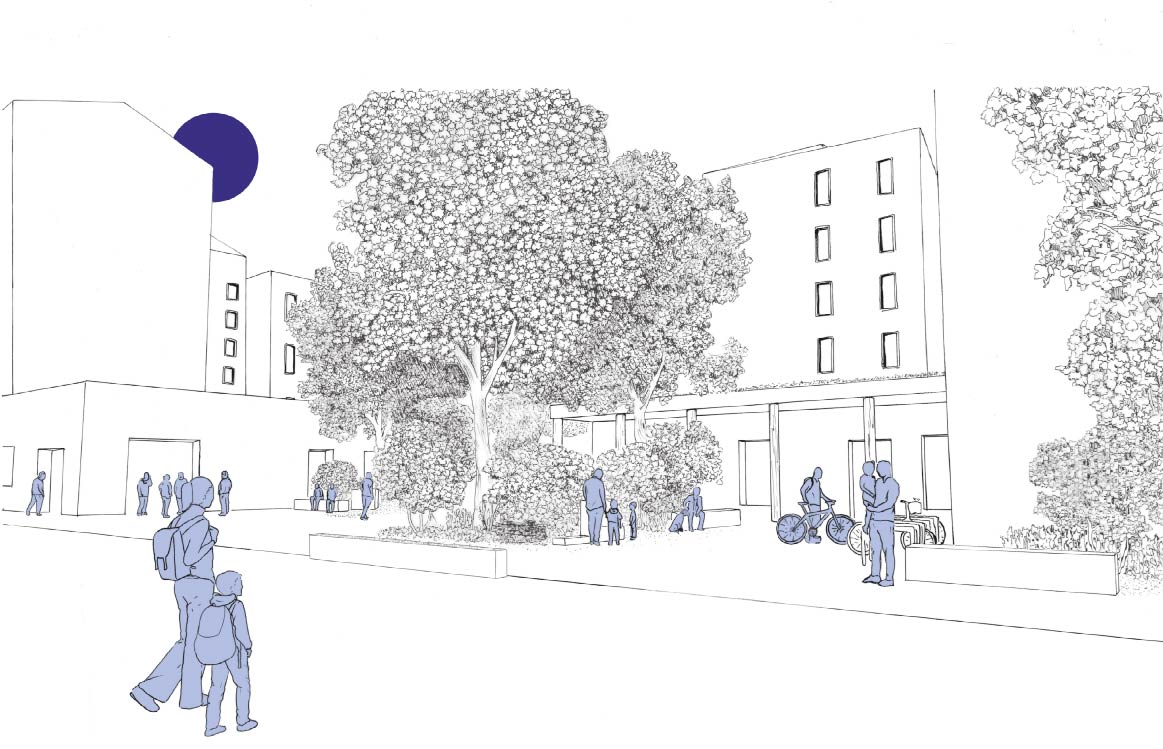Sarah Jaccomard
L’îlot Mazagran. A Lyon, proposition d’adaptation d’un îlot habité à la crise climatique.
Avec les prévisions de longues périodes de canicules avec nuits tropicales en milieu urbain de plus en plus longues, les épisodes de sécheresses et les pénuries d’eau et d’énergie qui en découlent, il devient nécessaire de gérer collectivement nos ressources et nos lieux de vies pour que ces derniers continuent d’être habitables dans les années à venir, et que cette habitabilité concerne également celles et ceux dont les formes d’habiter sont plus précaires, qui sont donc dépendant.e.s de l’espace et des équipements publics pour vivre en ville. Parmi ces territoires communs amenés à se transformer, les centres urbains, déjà fortement artificialisés, qui concentrent les services et les personnes, sont une cible importante des stratégies d’adaptation aux effets du réchauffement climatique mises en place par les pouvoirs publics. De plus, pour répondre à la demande de logements sans amplifier le phénomène d’étalement urbain, les collectivités sont appelées à les densifier, à faire la ville sur la ville. Ces projets s’appliquent ainsi sur des lieux, des bâtiments, des sols déjà investis, ayant leurs propres histoire, usages et enjeux. Ce projet de diplôme est l’opportunité de travailler la réécriture urbaine d’un lieu, des outils et des échelles impliqués lors de sa transformation pour s’adapter au contexte de crise des ressources, des modes d’habiter et de co-habiter.
Pour réfléchir à cette question, je travaille à la Guillotière, quartier du centre de Lyon dans le nord du 7ème arrondissement, qui est actuellement la cible de nombreuses opérations d’aménagement dirigées par la métropole de Lyon. Ce quartier a longtemps abrité de nombreuses activités artisanales et industrielles avant de devenir une centralité commerçante. Très minéral, il est également mal adapté au futur climat lyonnais. C’est pourquoi la ville souhaite le transformer. Ces projets ne sont cependant pas toujours bien perçus par les habitants du quartier, qui dénoncent la non prise en compte des besoins locaux.
Depuis quelques années, des collectifs d’habitants se sont organisés pour défendre leur vision du quartier et participer aux décisions prise face aux projets de la métropole.
Cette opposition entre la métropole et les collectifs d’habitants se cristallise aujourd’hui autour d’un îlot, appelé îlot Mazagran. Sa position stratégique et son bâti bas, constitué d’ateliers et de hangars datant du début du XXème siècle, en font, dans sa forme actuelle, la cible d’une OAP par la métropole, ainsi qu’un lieu emblématique de l’urbanité du quartier pour les habitant.e.s, qui contestent l’OAP. C’est également un lieu investi et habité, support de nombreuses activités de proximité.
Dans sa forme, son emplacement urbain, et dans le contexte de mobilisation habitante autour de lui, cet îlot me paraît intéressant pour travailler sur l’adaptation de la ville au réchauffement climatique à petite échelle. Le travail de ce diplôme est l’occasion de réfléchir à l’évolution de ce morceau de sol urbain à travers l’adéquation entre planification urbaine et besoins habitants, tout en explorant les conditions de réalisation d’un refuge climatique urbain à cet endroit. Il s’appuie sur 5 enjeux de projet :
- Prendre en compte la richesse de typologies et d’usages du lieu
- Créer un îlot de fraîcheur de proximité pour tou.te.s
- Créer du logement abordable et durable face à la crise climatique
- Contribuer à gérer durablement l’eau urbaine
- Implanter des équipements publics
La stratégie développée pour répondre à ces enjeux regroupe à la fois du logement, de l’espace public, des locaux d’activité et des équipements publics sur l’îlot. Il s’agit d’équilibrer la forme du projet en fonction des usages existants et projetés sur l’îlot et dans le quartier, des gabarits en présence, des rues, tout en proposant une réponse architecturale, urbaine et programmatique restant au service du quartier.
C’est également une proposition de mise côté à cote de différents types de gestions collectives des ressources et du sol : publique, associative, ou privée ; et des formes spatiales qui en résultent.






